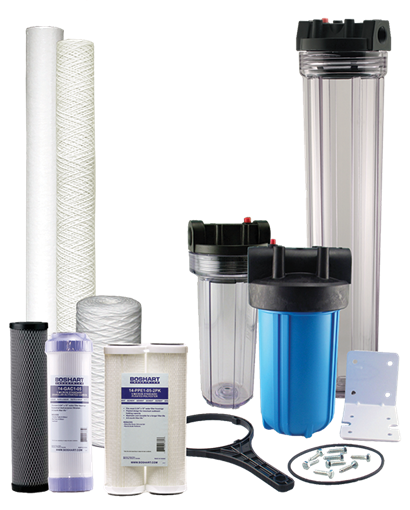What do we mean by “Filtration"?
What do we mean by “Filtration"?
Filtration is a process used to separate solids from liquids using a filter medium that allows the fluid to pass through but not the solid. Our filter housings & sediment cartridges are not limited to water applications. They are commonly used in a wide range of industrial and manufacturing applications which may include, but are not limited to chemicals, coolants, food and beverage, oils, petrochemicals, pharmaceuticals, and photographic to mention a few. However, the main focus of this article is water filtration.
WHAT DO WE MEAN BY “WATER FILTRATION”? 
Water filtration must not be confused with water treatment or water purification. Basic sediment and taste and odor filtration will not make non-potable water (microbiologically unsafe) into potable water (microbiologically safe).
Traditional water filtration (Sediment / Taste & Odor) must only be used on water that has been professionally tested and confirmed to be “potable” (safe to use for drinking and cooking). Traditional filtration is only capable of removing sediment or unpleasant taste and odor from the water. Sediment filters including spun poly, pleated, and string wound will improve the appearance of your water, while carbon filter cartridges such as granular activated carbon, carbon block, and carbon wrapped type cartridges will remove unpleasant odors and improve the taste of the water. The bottom line is that the water filtered through these cartridges is unsafe, it will look cleaner and clearer, smell and taste much better, but it will remain unsafe to drink!
A DEADLY SERIOUS NOTE ABOUT UNSAFE WATER
As mentioned, traditional Sediment and Taste & Odor filtration is not water treatment. If your water source contains harmful bacteria and is found to be unsafe for drinking or cooking the installation of a water treatment / purification system must be installed to make the water safe for human consumption.
Unsafe water is dangerous, it may cause serious illness or even death. We are not qualified to advise on water treatment filtration systems. One must consult with a water treatment / purification specialist to determine what type of system is required and best suited for your particular water condition. They may recommend a Reverse Osmosis (RO) Filtration System or Ultraviolet (UV) Filtration Systems in series with other specialized filters if the water contains any of the following: Algae, E. coli, Cholera, Fungi, Cryptosporidium, Giardia, Dysentery bacilli, Salmonella, Mycobacterium tuberculosis, or Streptococcus.
PRE & POST FILTRATION FOR WATER TREATMENT SYSTEMS
Boshart does not carry Water Treatment Filtrations Systems such as R.O. (Reverse Osmosis) or U.V. (Ultraviolet) Filters. However, we do carry filter housings & cartridges which are used in all of these systems for both “PRE” & “POST” filtration!
RO Pre-Filter(s): Water from the cold-water supply line enters the Reverse Osmosis Pre Filter first. There may be more than one pre-filter used in a Reverse Osmosis system, the most common being sediment and carbon filters. These pre-filters protect the costly RO membranes by removing sand, silt, dirt, and other sediment that could clog the system. Additionally, carbon filters may be used to remove chlorine, which can damage the RO membranes.
UV Pre-Filter(s): Pre-filters must be installed to remove particulates from water that may block UV light from reaching bacteria and producing its effects. These hindering elements could be dirt, sediments, debris, and absorbing compounds that can shield bacteria from UV lights or even absorb these lights. Only when the particulate is removed from water, can UV filters achieve their full effectiveness. Typically, these sediment filter cartridges have a 5-micron rating, but lower micron rating sediment filters are also available. The importance of sediment pre-filters cannot be overstated.
RO / UV Post filter(s): After the water leaves the UV filtration System or the R.O. storage tank, but before going to the drinking water faucet, the treated water goes through a final “post filter”. The post filter is usually a carbon filter. Any remaining tastes or odors are removed from the product water by post filtration a.k.a. “polishing”.
